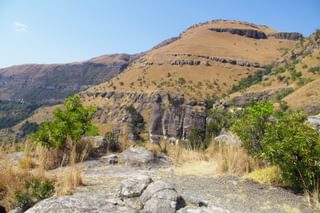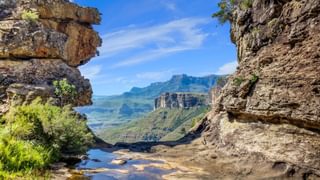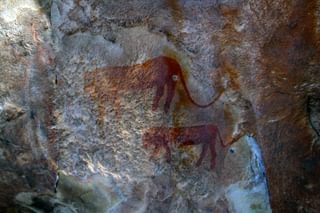
As they say, it’s all in the name. Today ‘Drakensberg’ means ‘dragon mountain’, but I prefer the attention grabbing and brilliantly descriptive ‘Barrier of Spears’, a fitting title given by the Zulus to South Africa’s most imposing range of jagged peaks. The scale is nothing short of overwhelming, but for those who dare to venture into this world of river and rock, the rewards are endless.

The Drakensberg range stretches over 200 km and forms an almost impenetrable border between the mountain kingdom of Lesotho and KwaZulu Natal. There are hidden valleys, majestic peaks and raging waterfalls to discover, as well as wild game, ancient San cave paintings and a whole lot of open space. It’s a place for nature lovers, hikers and anyone who appreciates a good view.

The Drakensberg area has 4 main valleys: Champagne, Cathedral Peak, Royal Natal National Park and Amphitheatre, and Middledale Pass. Each are spectacular in their own way. Some of the peaks are 3300 m high, but you don’t have to conquer them to be able to enjoy what the Drakensberg has to offer. Many of South Africa’s best hikes can be found here, and one of our favourites is the Central Drakensberg trail to ‘World’s End’ in the Giant’s Castle area. Two more excellent names.

We left the car armed with a map and a picnic (which we quickly ate when we realised there were baboons around!), and headed off along rivers, through grasslands and up hills. On the way we came across a heard of wild Eland, the biggest antelope in Africa. They were pretty docile and didn’t seem to be after our sandwiches so we watched them for a while before continuing with our mission, to reach an incredible plateau with 360 degree views.

However we didn’t linger at the end of the world for long. The area is renowned for its spectacular electrical storms, and whilst it isn’t advisable to be on a hilltop during such events, they really are a sight to behold. Storms here are often without rain (or sometimes they come with hailstones the size of golf balls!), and the lightning strikes every other second. We’ve spent many a happy afternoon admiring South African storms, they truly are some of the best in the world. In our next life we’re going to be storm chasers!

As we were taking in the view, dark clouds began to close in, the skies came alive with fire and the hairs on our arms were soon standing to attention. Torn between staying to watch the show or hot-footing it back to the car, we eventually decided as the tallest objects on the ridgeline we were sitting ducks and ran all the way back. Don’t think I’ve ever moved so fast.

Another of our favourite places to hike is the Royal Natal National Park, and in particular the incredible amphitheatre, a 5 km long cliff with a chain ladder for the fearless to climb to the top. It’s also here that you’ll find Tugela Falls, the second highest waterfall in the world.

It’s of course not all about the hiking. There are all the usual activities such as horse riding, white water rafting, abseiling, game viewing and even fishing, as well as some excellent local craft trails and a fabulous range of local accommodation.

Perhaps the most fascinating activity however is to look at some of the 4000 ancient San cave paintings found all over the Drakensberg area. The San people (or bushmen) were the first inhabitants of the Drakensberg, and are believed to have been eradicated by farmers in the 1800’s. Their painting legacy is particularly prevalent at Giant’s Castle where there’s a large sandstone cave with some of the best preserved rock art on the continent. The museum here also gives a decent glimpse into San life.































